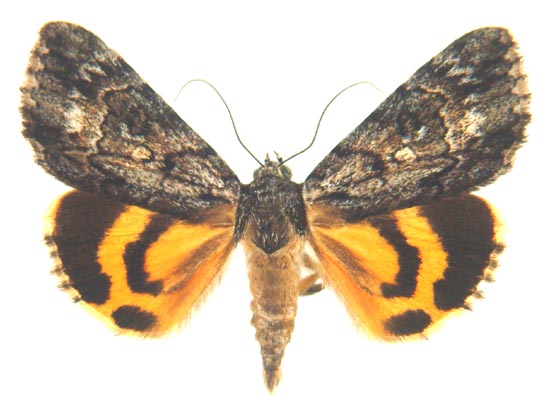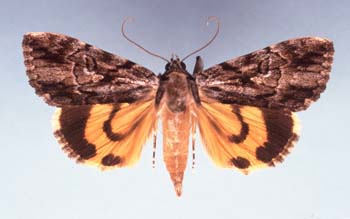Catocala bastropi
kah-TOCK-uh-lahMBAGH-strop-eye
Kons & Borth, 2017

|
|
Updated as per personal communication with Ricky Patterson; 2017 publication by Kons & Borth, describing Catocala bastropi; May 22, 2017 |

The moth from Louisiana is much more likely the recently (Kons & Borth, 2017), described Catoala bastropi from Texas, Louisiana, Arkansas, Oklahoma and Missouri. Specimens originally identified as louiseae from those four states are more likely Catocala bastropi.
TAXONOMY:Superfamily: Noctuoidea |
I think Catocala bastropi is probably limited to the five states listed above, and the very similar Catocala louiseae is probably limited to North Carolina, South Carolina (unconfirmed), Georgia, Florida and Alabama.
There is a distinct white "smile" (in spread specimens) between the reniform and subreniform spots. There is also a narrow but distinct white line immediately following the black postmedial line.The hindwing is a deep yellow orange and the outer black band is interrupted and then followed by a dot, ending before the inner margin. The specimen to the right, likely from Georgia courtesy of James Adams, is probably Catocala louiseae. |
 |
Much more detailed information and many images are available in "A New Species of Catocala (Lepidoptera: Noctuidae) from the South Central United States" by Hugo L. Kons, Jr. and Robert J. Borth. I am pretty sure this is a 2017 publication.
There is also another unnamed phenotype with a wider range from Massachusetts to Texas. It seems more coastal in the various collecting locales which include states with either louiseae or bastropi. Identifying Catocala just got a little more difficult!
Vaccinium ....... |
Blueberry |
Please send sightings/images to Bill. I will do my best to respond to requests for identification help.
Enjoy one of nature's wonderments: Live Saturniidae (Giant Silkmoth) cocoons.

|
butterfly to the left, a link to many worldwide insect sites. |
Return to Canadian Index
Return to Main Catocala Index